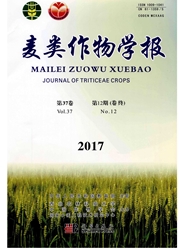

 中文摘要:
中文摘要:
为给滴灌超高产冬小麦的水氮运筹提供依据,采用水、氮两因素三水平的田间裂区试验(灌水量设1 125、2 250和2 700m3·hm^-2三个水平,分别用W1、W2和W3表示;施氮量设0、180和270kg·hm^-2三个水平,分别用N0、N1和N2表示),研究了9个水氮处理对麦田0-140cm土层耗水量、冬小麦品种新冬41号群体叶面积指数、干物质和产量及水、氮利用效率的影响。结果表明,增加滴灌量直接提高了0-60cm土层含水量,间接减少了小麦对60-140cm土层储水的消耗量,增加了麦田总耗水量;施氮量对土壤含水量影响不显著。在相同水分条件下,增加施氮量提高了小麦产量;而仅在N2条件下,滴灌量显著影响产量,W2和W3的产量均显著高于W1,但W2和W3间差异不显著;加大滴灌量或施氮量均增加孕穗至成熟期间群体叶面积指数、光合势和干物质积累量,减少花前营养器官储存物质的转运量、转运效率和对籽粒产量的贡献率,增加花后物质生产对籽粒产量的贡献率和产量,降低灌溉水利用效率和氮肥农学利用效率;适宜水氮组合较单灌水或单施氮处理增产更显著,并同时提高水、氮利用效率,以W2N2、W3N2组合产量较高(9 051.9、9 189.6kg·hm^-2)。综合产量和成本,春季总滴灌量2 250 m^3·hm^-2(拔节期、孕穗期、开花期各750m3·hm^-2)、总施氮量270kg·hm^-2(拔节期90kg·hm^-2、孕穗期180kg·hm^-2)的水氮组合为北疆滴灌冬小麦超高产田水氮运筹的适宜模式。
 英文摘要:
英文摘要:
In order to provide evidence for irrigation and nitrogen application to the super high-yielding winter wheat production, two split-plot experimental designs were conducted with different irrigation and nitrogen to study the water consumption characteristics and water and nitrogen use efficiencies. There were three irrigation rates (W1 1 125 m^3·hm^-2,W2 2 250 m^3·hm^-2,and W3 2 700 m^3·hm^-2)and three nitrogen rates (No 0 kg·hm^-2,N1 180 kg·hm^-2,N2 270 kg·hm^-2) for nitrogen experiment. The effects of nine treatments on water consumption in 0-140 cm soil layers,leaf area index (LAI) ,dry matter,yield,and water and nitrogen use efficiency were studied. The results showed that increasing drip irrigation amount mainly improved soil water contents of 0-60 cm soil layers, and indirectly reduced the storage consumption of 60-140 cm soil layers,through significantly increased total water consumption in the winter wheat field, but the effect of increasing nitrogen application on soil water content was not obvious. The yield was increased with the increase of fertilize under the same ir- rigation levels,but the yield was only increased with the increase of drip irrigation amount under N2 conditions. With the increase of drip irrigation amount (or N application rate) from booting to maturity,LAI,photosynthetic potential and dry matter accumulation amount of population were increased,and the dry matter storage in vegetative organs before anthesis transferring to the grain quantity, translocation ratio and contribution for grains were reduced, and the contribution of dry matter accumulation amount after anthesis to grains was increased,while the agronomic nitrogen use efficiency of nitrogen (AEN) was reduced. The optimal water and nitrogen combination increased yield more obvi-ously than single factor(irrigation or N), with the improvement of water and nitrogen use efficiency. Higher yields(9 051.9 and 9 189.6 kg·hm^-2) were obtained under W2N2 and WaN2 treatments. Taking the yield and cos
 同期刊论文项目
同期刊论文项目
 同项目期刊论文
同项目期刊论文
 期刊信息
期刊信息
